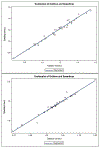Development, Validity, and Reliability of a Novel Walking Speed Measurement Device: the GaitBox
- PMID: 33271417
- PMCID: PMC7902333
- DOI: 10.1016/j.gaitpost.2020.11.009
Development, Validity, and Reliability of a Novel Walking Speed Measurement Device: the GaitBox
Abstract
Background: Gait speed is an important measure of health status for older adults and individuals with neurological conditions. Literature reports that measurements made by people are not as accurate as automatic timers.
Research question: Is the GaitBox (GB), a device to measure walking speed (WS) automatically and accurately, a valid approach to walking speed measurement in a clinical setting?
Methods: Two prospective validation studies were completed comparing the GB to human timers (HT) and the Sprint Timing System (STS). Subjects were recruited from convenience samples of healthy older adults (S1, N = 35, 72.4 + 7.4 years of age) and individuals with Spinal Cord Injury (SCI), Traumatic Brain Injury (TBI), or unknown / no diagnosis (S2, N = 44, 35.3 + 13.5 years of age). Subjects completed 4 timed walks. The GB, HT, and STS simultaneously measured WS across a 4 m or 10 m course. Protocol followed an adapted version of the NIH Walk Test. Subjects were instructed to walk at a normal pace. Validity and reliability were determined using Pearson correlations, absolute mean differences, Intraclass Correlation Coefficients (ICC's) and Bland-Altman plots.
Results: WS measured in both studies demonstrated strong correlations between GB and STS (r = 0.98-0.99, p < 0.0001), excellent test-retest reliability GB ICC's (0.93-0.94), no systematic bias, and good precision. In S1 and S2, ICC's between GB and STS were excellent at 0.91 and 0.93, respectively.
Significance: Considering the increased use of WS as a clinically relevant measure of mobility, functional decline, and recovery, accurate measurement of WS are important. These studies show the GB is a valid and reliable measurement tool within various populations completing the 4 m and 10 m walk tests at a usual speed. Additional populations and walking distances should be evaluated further. Due to its accuracy, the GaitBox is a valid alternative to HT in the clinic setting.
Keywords: Walking speed; functional status; gait; older adults; technology.
Copyright © 2020 Elsevier B.V. All rights reserved.
Conflict of interest statement
CONFLICT OF INTEREST STATEMENT:
The Author(s) declare that there are no conflicts of interest.
Figures




References
-
- Abelian Van Kan G, Rolland Y, Andrieu S, Bauer J, Beachet O, et al., Gait Speed at Usual Pace as a Predictor of Adverse Outcomes in Community-Dwelling Older People an International Academy on Nutrition and Aging (IANA) Task Force, The Journal of Nutrition, Health & Aging. 13(10) (2009) 881–889. - PubMed
-
- Lusardi MM, Is walking speed a vital sign? Absolutely, Top Geriatr Rehabil. 28(2) (2012) 67–76. doi:10.1097/TGR.0b013e31824385a4. - DOI
Publication types
MeSH terms
Grants and funding
LinkOut - more resources
Full Text Sources
Other Literature Sources

